As an Amazon Associate KitchenwareSets.com earns from qualifying purchases.
Kitchen Wall Decor That Looks Perfect Above Your Table
Staring at that big, empty space above your kitchen table again? It feels like it’s just waiting for the perfect touch.
That blank wall is a common design challenge, making an otherwise cozy dining area feel unfinished. You know wall decor is the solution, but the fear of choosing the wrong size or style can be paralyzing.
To decorate the wall above a kitchen table, choose decor that is about two-thirds the width of your table and hang it so the bottom is 6-10 inches above the tabletop. This guide will give you stunning ideas and the simple design rules to execute them with confidence.
That Blank Wall Above Your Kitchen Table? Here’s How to Fix It for Good
That empty wall behind your kitchen table isn’t just a blank space; it’s an opportunity. It’s the backdrop for family dinners, morning coffee, and conversations with friends. Getting the kitchen table wall ideas right can transform the entire feel of your dining area, turning it from a simple spot to eat into the true heart of your home. But the pressure to find the perfect solution can lead to endless searching for design inspiration without ever taking action.
This guide is designed to give you more than just a list of what to hang above a dining table. We’ll provide the design confidence you need by first explaining the simple rules professionals use. With this knowledge, you can choose the right kitchen wall decor and create a focal point that looks intentional, balanced, and perfectly suited to your home.
Before You Hang Anything: The 3 Golden Rules of Dining Wall Decor
Before we dive into the inspiring ideas, let’s cover the foundational interior design principles that guarantee a great result. Understanding these three simple design rules for scale, placement, and style will empower you to hang any decor with the confidence of a professional. These rules are the key to creating a visual anchor that connects your decor to your furniture, making the entire space feel cohesive.
To determine the right size decor, follow the 2/3 Rule: Your artwork or arrangement should be roughly two-thirds the width of your table. For hanging height, the center of the art should be at eye-level (57-60 inches from the floor), or the bottom of the frame should be 6-10 inches above the tabletop.
- The Rule of Scale & Proportion: The most common mistake is choosing art that’s too small. A tiny picture floating above a large table will always look out of place. Your wall decor—whether it’s a single piece or a gallery wall—should have a total width that is about 2/3 to 3/4 of the width of your table. This creates a pleasing proportion where the table remains the anchor of the setting.
- The Rule of Placement & Height: Where you hang your decor is just as important as what you hang. According to design best practices, the center of your artwork should be at average eye-level, which is between 57 and 60 inches from the floor. When hanging above furniture like a kitchen table, an even better rule is to ensure the bottom of the lowest frame is 6 to 10 inches above the tabletop. This creates a visual connection and prevents the art from looking disconnected.
- The Rule of Style & Cohesion: Your wall decor should feel like a natural extension of your room’s existing style. If you have a rustic farmhouse table, consider decor made from natural wood or metal. For a modern dining space, abstract kitchen art or a minimalist mirror would be a great fit. The goal is to choose a theme or color palette that complements your furniture, lighting, and overall aesthetic.
9 Stunning Kitchen Wall Decor Ideas to Elevate Your Dining Space
Now that you’re armed with the golden rules of design, you can confidently explore different kitchen wall decor ideas. Here are nine stunning and achievable options, ranging from modern and minimalist to rustic and cozy. Each idea is presented with practical tips and steps, allowing you to apply the principles of scale, placement, and style to create a beautiful focal point in your eat in kitchen or dining room.
1. The Single Statement Art Piece
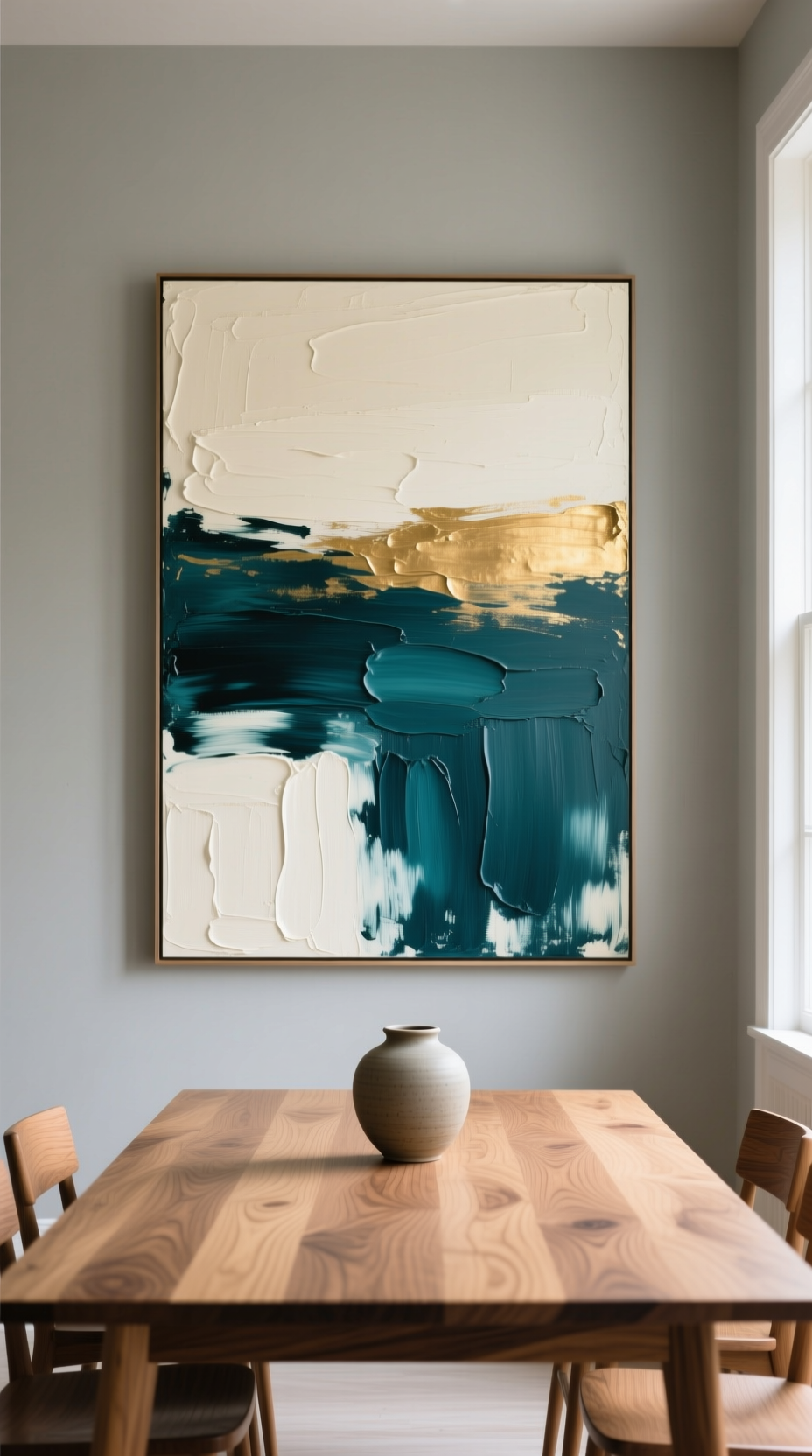
Pin this powerful look to your ‘Dining Room Inspo’ board!
For a simple yet dramatic impact, nothing beats a single piece of oversized wall art. This approach creates an instant focal point and sets the mood for the entire dining space. A large horizontal canvas, whether it’s an abstract piece or a calming landscape, can make a room feel more expansive and sophisticated. Choosing one large piece is often easier than curating a collection, making it a perfect solution for creating a high-end look with minimal effort.
Materials Needed:
- One large piece of canvas or framed art (aim for 2/3 the width of your table)
- Heavy-duty picture hanging wire (if not already installed on the art)
- Two heavy-duty wall hooks or anchors rated for the art’s weight
- Tape measure
- Pencil
- Laser level or bubble level
Step-by-Step Directions:
- Measure & Center: Measure the width of your table and divide by two to find the center. Lightly mark this spot on the wall. Measure the width of your wall space to ensure the art is also centered on the wall.
- Calculate Height: Determine your ideal hanging height. Either mark 57-60 inches from the floor (this will be the center of your art) OR measure 6-10 inches up from your tabletop (this will be the bottom of your art).
- Mark Hook Points: Measure the distance from the hanging wire (when pulled taut) to the top of the frame. Use this measurement to mark the precise spots for your wall hooks based on your height calculation.
- Install & Level: Install your hooks or anchors. Carefully hang the artwork. Use your level to ensure it’s perfectly straight and adjust as needed.
Pro-Tip: Before buying, use painter’s tape to outline the dimensions of the art on your wall. This helps you visualize the scale in your actual space and avoid costly mistakes.
2. The Symmetrical Grid Gallery Wall
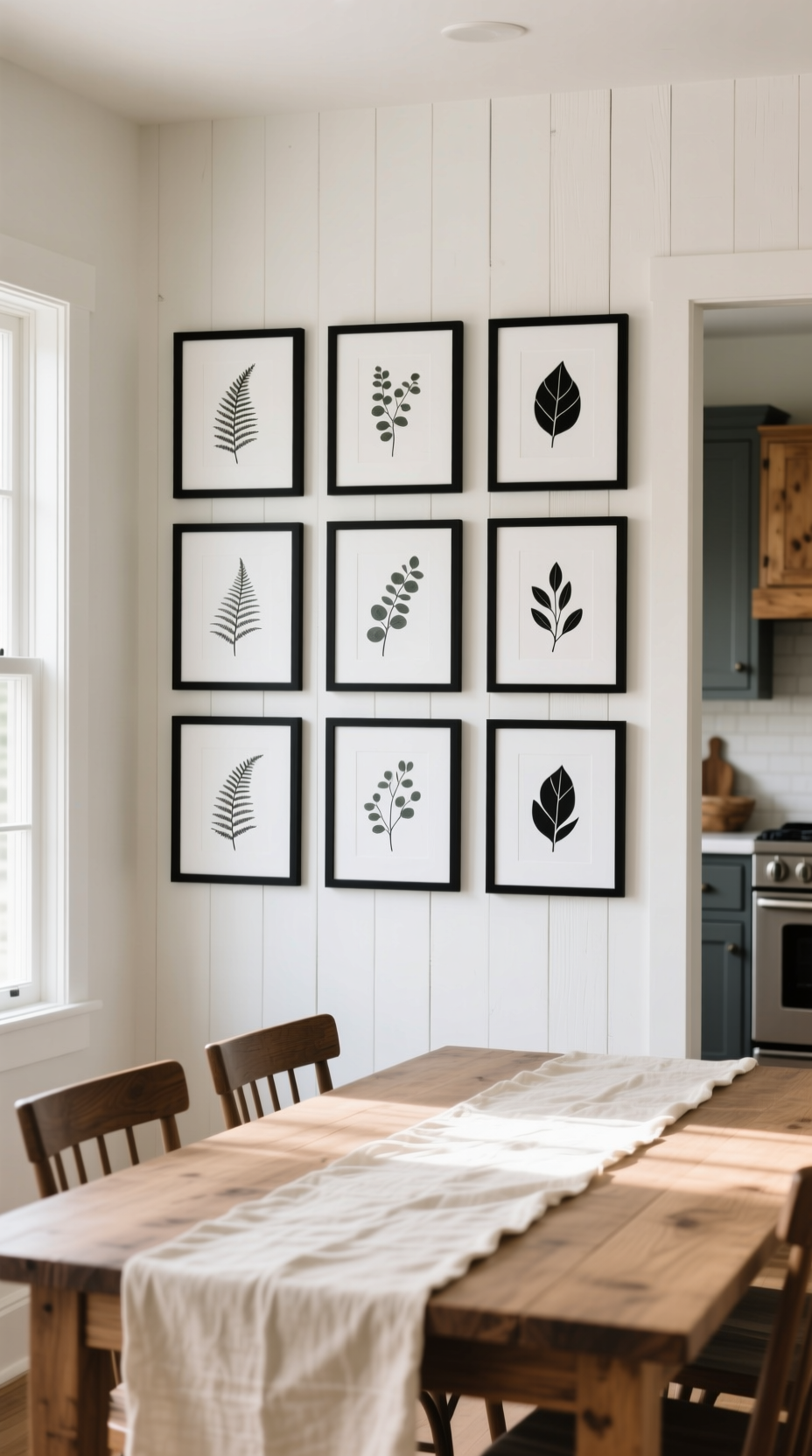
Save this classic and clean gallery wall idea!
A symmetrical gallery wall offers a classic, organized, and high-impact look. Using a set of identical frames to create a perfect grid is a fantastic way to fill a large wall and display a collection of related prints, like botanical illustrations or black-and-white photos. The key to this dining room gallery wall is precision: matching frames and consistent spacing are what make the arrangement feel polished and intentional rather than cluttered.
Materials Needed:
- A set of identical frames (e.g., nine 12×12-inch square frames)
- Art prints of your choice
- Kraft paper or wrapping paper
- Scissors
- Painter’s tape
- Tape measure, pencil, and level
- Picture hanging nails for each frame
Step-by-Step Directions:
- Create Templates: Trace each frame onto kraft paper and cut out the shapes. These are your templates.
- Plan Your Layout: Use painter’s tape to arrange the paper templates on the wall. Aim for a consistent spacing of 2-3 inches between each template. Adjust until the entire grid is centered over your table and at the correct height.
- Mark Nail Holes: Once the layout is perfect, mark the spot for the nail through the top center of each paper template.
- Hang Your Frames: Remove the templates and hammer in your nails on the marked spots. Hang your framed prints, using a level to check each one.
Lesson Learned: Creating paper templates feels like an extra step, but it is the single best way to guarantee a perfect gallery wall layout without making dozens of unnecessary holes in your wall.
3. The Light-Maximizing Round Mirror
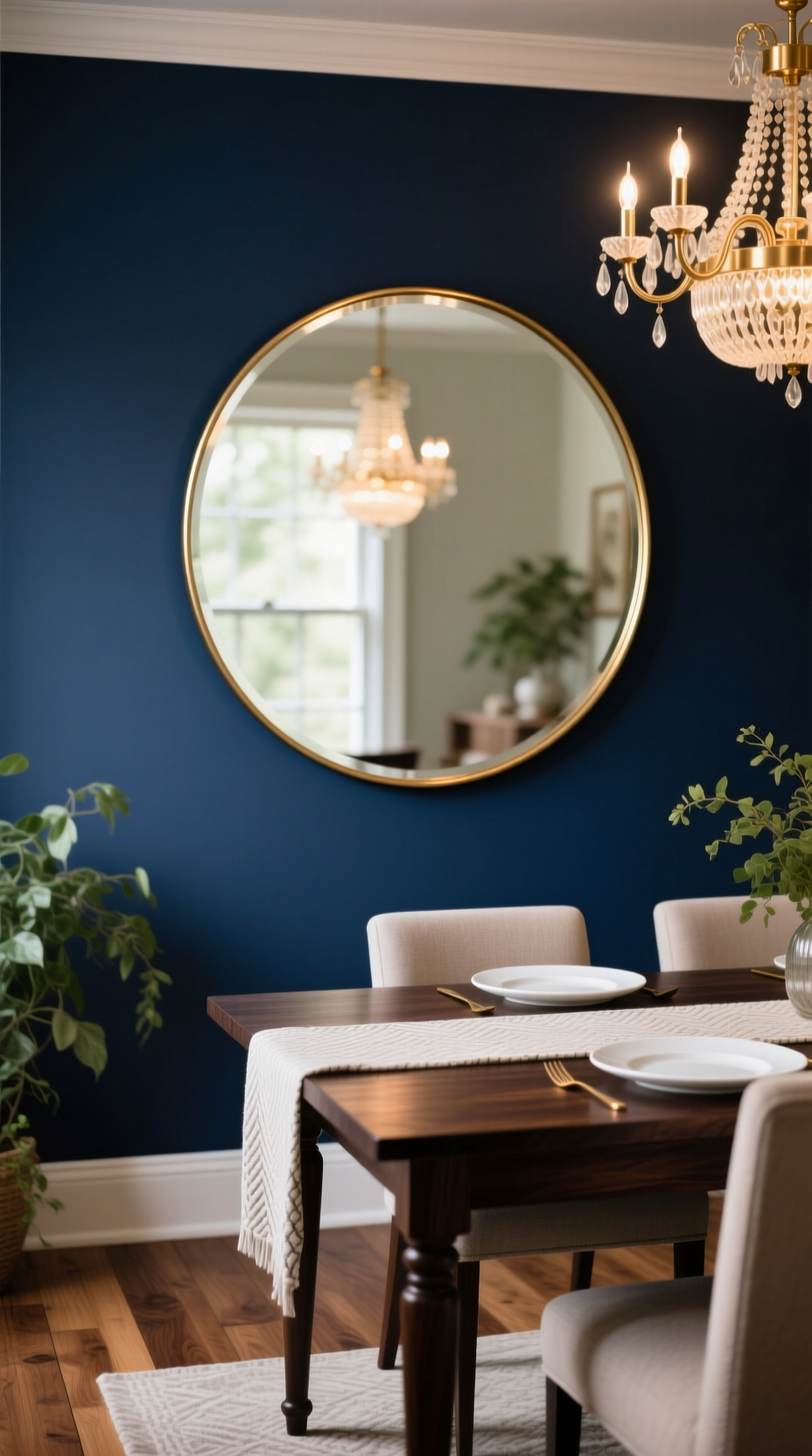
Pin this chic idea to make your dining space feel bigger and brighter!
When deciding between art vs mirror above a table, a mirror offers unique functional benefits. A large, decorative round wall mirror is a perfect solution for making a small dining room look bigger. It works by reflecting light—both natural and artificial—around the room, creating an illusion of depth and brightness. The soft curves of a round mirror can also break up the hard lines of tables and windows, adding a touch of elegance to the space.
Materials Needed:
- One large round mirror (at least 30 inches in diameter for impact)
- Heavy-duty wall anchor and screw (ensure it’s rated for well above the mirror’s weight)
- Stud finder
- Power drill
- Tape measure, pencil, and level
Step-by-Step Directions:
- Locate a Stud: Mirrors are heavy. Use a stud finder to locate a wall stud centered over your table. This is the most secure place to hang.
- Mark Your Height: Following the placement rules, determine the center point for your mirror. The bottom should be 6-10 inches above the table. Mark the spot for your anchor screw.
- Install the Anchor: If you can’t hit a stud, drill a pilot hole and install a heavy-duty wall anchor rated for the mirror’s weight. Screw it in, leaving it protruding about 1/4 inch from the wall.
- Hang with Care: Carefully lift and hang the mirror on the screw. Gently press on it to ensure it’s secure. Use a level on top to make sure it’s straight.
Pro-Tip: Before committing, consider what the mirror will reflect. Ideally, it should reflect a window, a beautiful light fixture, or another piece of art, not a cluttered doorway.
4. The Rustic Styled Floating Shelves
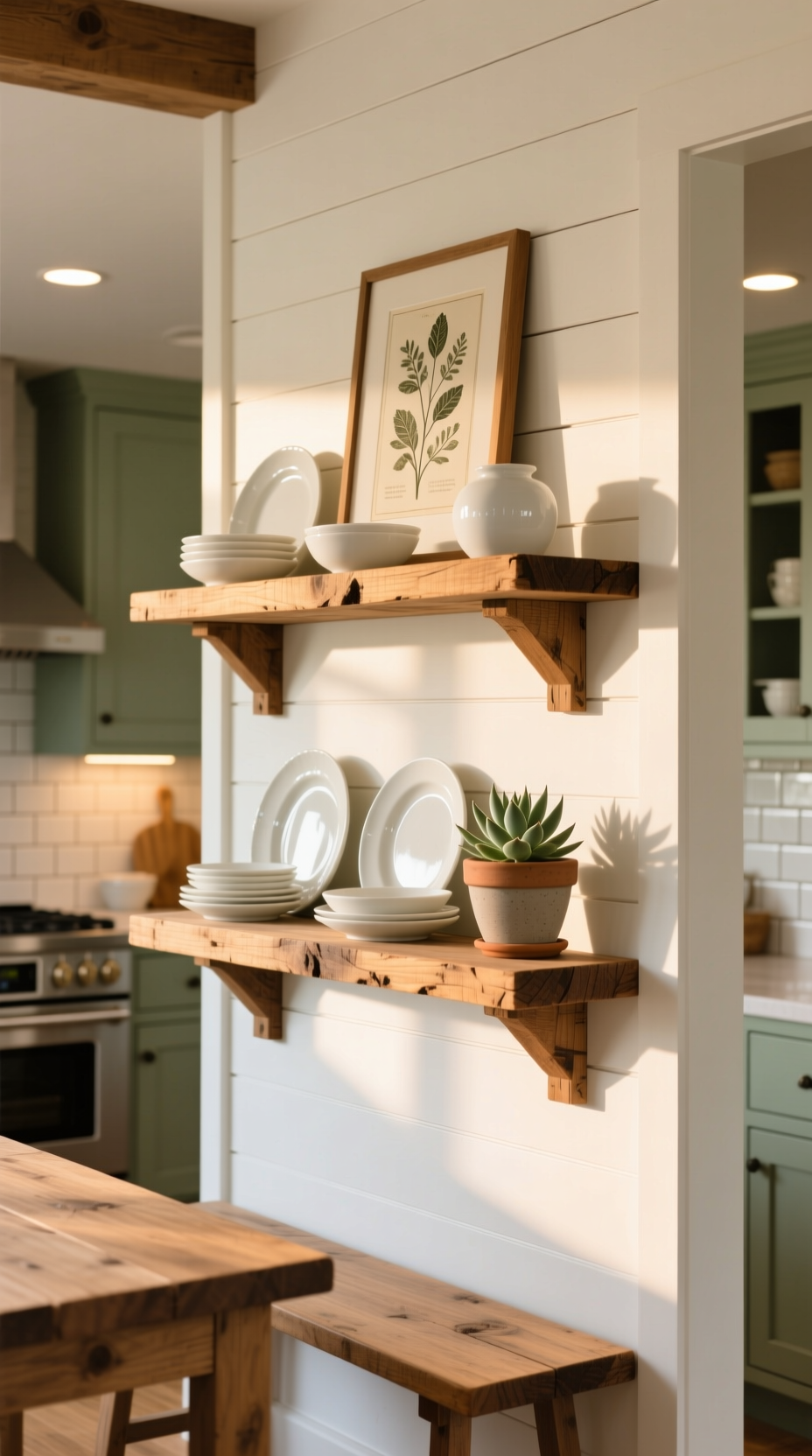
Save this beautiful and functional shelving idea!
For a look that’s both beautiful and practical, consider installing floating shelves above the table. This is a perfect farmhouse wall decor idea for the kitchen, adding warmth, texture, and valuable display space. You can style the shelves with a mix of decor objects like ceramics, small plants, and framed art, creating a layered and balanced arrangement. It’s a fantastic way to add personality and a bit of storage to your dining nook.
Materials Needed:
- A set of two floating shelves with heavy-duty brackets (ensure they are rated for significant weight)
- Power drill and bits
- Stud finder
- Long level (at least 24 inches)
- Tape measure and pencil
- Decorative objects: small plants, cookbooks, framed photos, ceramic vases, etc.
Step-by-Step Directions:
- Plan Placement: Decide on the height for your bottom shelf (at least 24 inches above the tabletop to avoid head bumps). Plan for 12-15 inches of space between the two shelves.
- Locate & Mark Studs: Use a stud finder to locate all wall studs in the area where the shelves will go. Mark them with a pencil. Installing shelves into studs is critical for stability.
- Install First Bracket: Hold the first shelf bracket against the wall, using your level to ensure it’s straight. Mark the drill holes over the stud locations. Drill pilot holes and secure the bracket.
- Install Remaining Brackets & Shelves: Attach the other brackets for the first shelf, constantly checking with your level. Repeat the process for the second shelf. Slide the wood shelves onto the brackets and secure them.
- Style Away: Arrange your decorative items. A good tip is to group items in threes and vary their height and texture for visual interest.
Pro-Tip: When styling floating shelves, place the largest items first (like a stack of books or a large vase) to act as anchors. Then, fill in around them with smaller objects.
5. The Modern & Flexible Picture Ledge
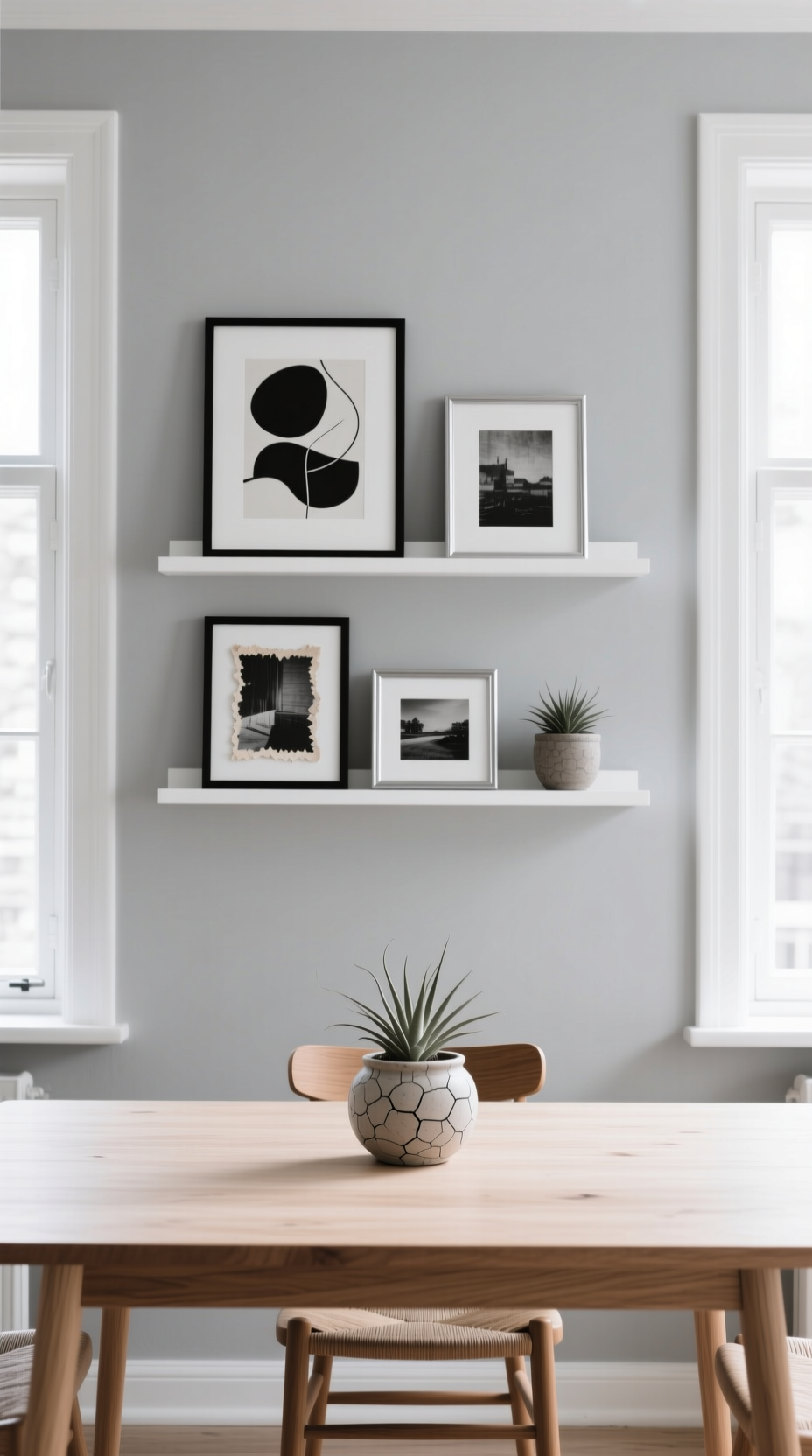
Love changing your decor? Pin this flexible picture ledge idea!
If you love to change your decor frequently, a picture ledge is your best friend. Unlike traditional floating shelves, these slim ledges are designed specifically for displaying frames. You can easily create a casual, layered look by overlapping frames of various sizes. This is a fantastic non-permanent wall decor solution for an apartment dining area, as you can swap out prints for the seasons without putting new holes in the wall each time.
Materials Needed:
- One or two picture ledges (choose a length that is about 2/3 the width of your table)
- Screws and wall anchors appropriate for your wall type
- Power drill
- Stud finder
- Level, tape measure, pencil
- A collection of lightweight framed art and photos in various sizes
Step-by-Step Directions:
- Determine Placement: Decide on the height for your ledge(s). Since you won’t be putting tall items on them, you can place the lowest ledge about 10-12 inches above the table.
- Mark & Level: Hold the first ledge against the wall at your desired height. Use a level to ensure it’s straight. Use a pencil to mark the screw holes through the pre-drilled holes in the ledge.
- Install: Remove the ledge. Drill pilot holes and insert wall anchors if you are not drilling into studs. Hold the ledge back up and drive the screws through to secure it to the wall.
- Layer Your Art: Arrange your framed pieces on the ledge. Overlap them slightly, placing larger frames in the back and smaller ones in front to create depth and a casual, collected look.
Lesson Learned: Picture ledges are perfect for renters or anyone who loves seasonal decorating. You can swap out prints and photos in minutes to completely change the vibe of the room.
6. The Textural Woven Basket Collection
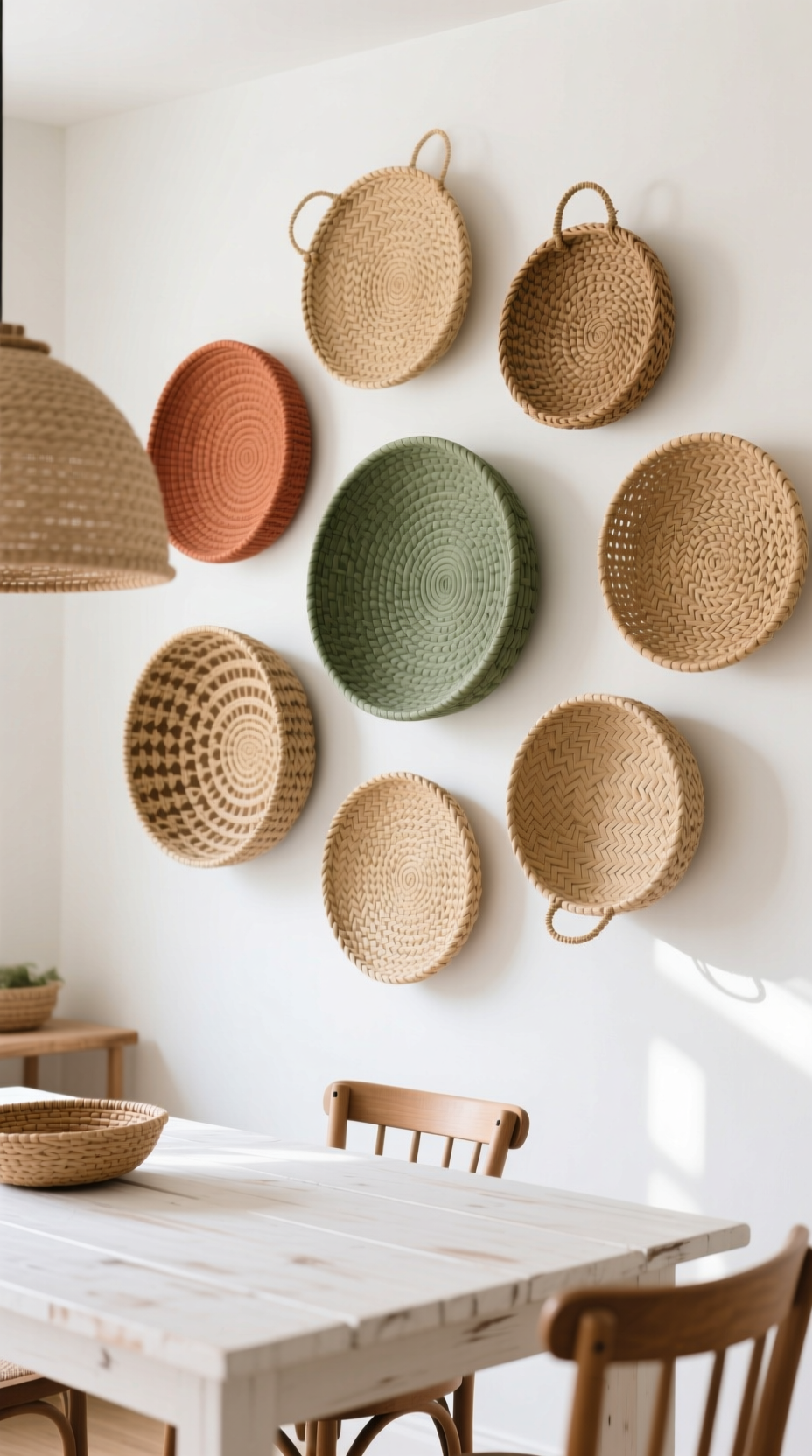
Pin this beautiful boho look for a touch of texture!
Looking for unique wall decor or something to put on your dining room wall instead of pictures? A collection of woven wall baskets is a perfect choice. This is a hallmark of boho wall decor, bringing incredible texture, warmth, and an organic feel to your space. You can collect baskets of different sizes, patterns, and natural tones made from materials like seagrass and rattan. Arranged in an asymmetrical cluster, they create a stunning, one-of-a-kind focal point.
Materials Needed:
- A collection of 5-9 flat-bottomed, decorative woven baskets or trivets in various sizes and patterns
- Small finishing nails
- Hammer
- Tape measure and pencil
- Kraft paper and painter’s tape (optional, for layout planning)
Step-by-Step Directions:
- Plan Your Layout: Arrange the baskets on the floor to figure out a composition you like. Start with the largest basket in the center and build outwards. An asymmetrical, organic cluster often looks best. (Optional: Use the paper template method from the gallery wall idea).
- Start with the Centerpiece: Determine the center of your arrangement over the table. Hammer a small nail into the wall at that point.
- Hang the Largest Basket: Most woven baskets have a small loop on the back for hanging. If not, you can simply slide the basket over the nail, catching the weave. Hang your largest basket first.
- Build Out the Cluster: One by one, add the remaining baskets around the central one according to your floor plan. Step back frequently to check the balance and spacing.
Pro-Tip: Don’t be afraid to mix and match! Combine baskets with different tones, textures, and weave patterns. The variation is what makes the collection visually interesting.
7. The Functional & Stylish Oversized Clock
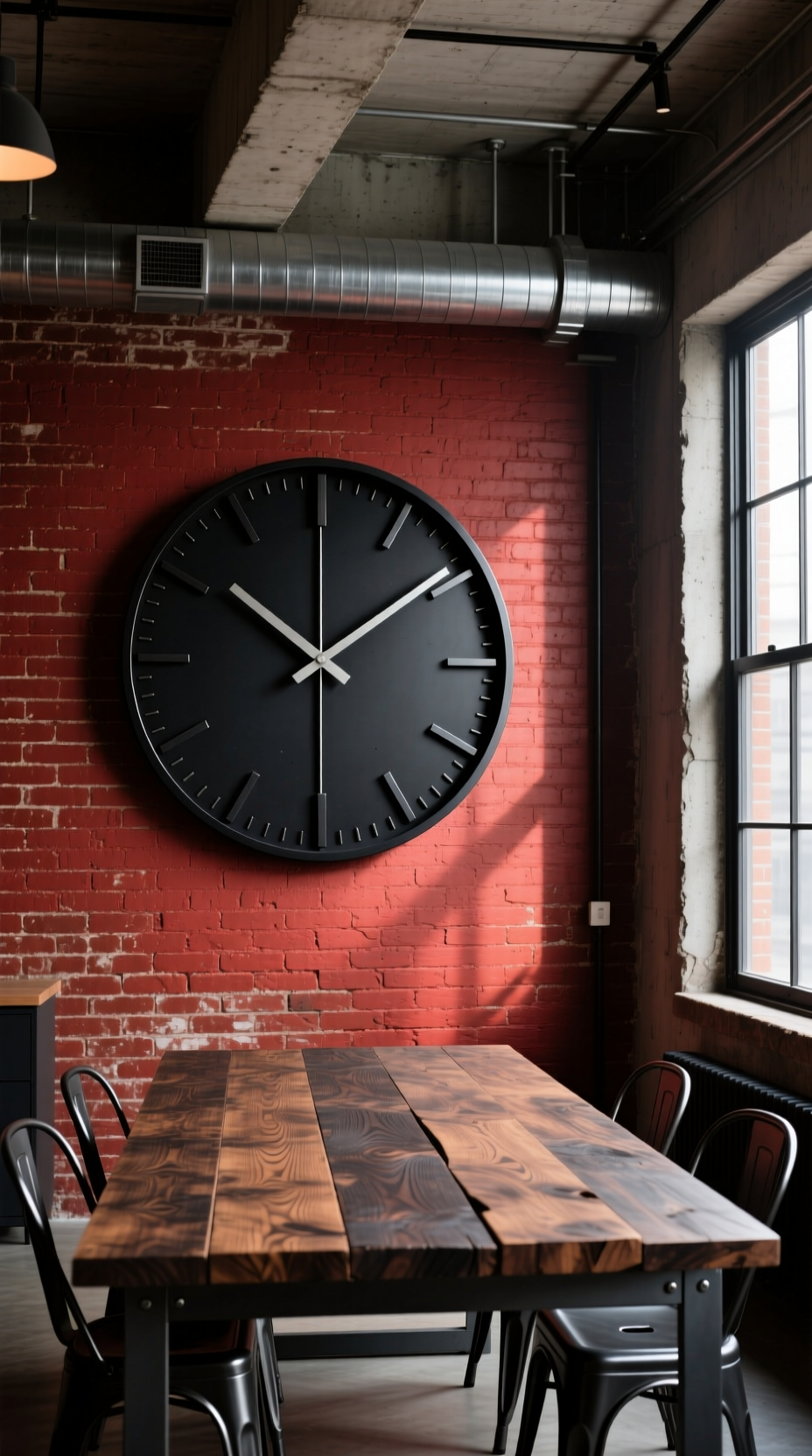
Save this timeless idea for a functional focal point!
A large wall clock for the kitchen can be both a practical timepiece and a piece of oversized wall art. This functional focal point works well in a variety of styles, from modern farmhouse to industrial. Applying the 2/3 rule, an oversized clock (30 inches or more) can have the same visual impact as a large piece of art. It fills the space, adds a graphic element, and serves a purpose—a perfect combination for a busy kitchen area.
Materials Needed:
- One oversized wall clock (30 inches or larger)
- Heavy-duty wall anchor and screw suitable for the clock’s weight
- Power drill
- Stud finder (recommended)
- Tape measure, pencil, level
- Batteries for the clock mechanism
Step-by-Step Directions:
- Find Your Center: Just like with a piece of art, find the horizontal center point over your table.
- Determine Height: The center of the clock should be at about eye level (57-60 inches from the floor). Mark this spot with a pencil. This is where your anchor will go.
- Install Anchor: Drill a pilot hole and install a heavy-duty anchor. Many large clocks are surprisingly lightweight, but it’s always better to be safe.
- Hang and Level: Insert the batteries into your clock and set the time. Hang the clock on the screw. Since most clocks are round, use a level on the very top edge to ensure the 12 is pointing straight up.
Pro-Tip: Choose a clock style that complements your existing decor. A rustic wood clock is perfect for a farmhouse kitchen, while a minimalist metal one suits a modern or industrial space.
8. The High-End Architectural Molding

Pin this DIY idea for an instant touch of elegance!
For a truly custom, high-end look on a budget, consider creating an architectural accent wall with DIY wall molding. By adding simple picture frame or box molding to the wall, you can create dimension, texture, and a sense of timeless elegance. This project adds major visual interest without adding clutter, making it perfect for a formal dining room or anyone wanting a sophisticated statement wall.
Materials Needed:
- Lightweight decorative molding (often sold in 8-foot strips)
- Miter saw or miter box and hand saw
- Tape measure, pencil, and a long level
- Construction adhesive (like Liquid Nails)
- Nail gun with brad nails (optional, but recommended)
- Caulk and caulk gun
- Paint (in the same color as your wall for a monochrome look)
Step-by-Step Directions:
- Design Your Boxes: Plan the size and number of your molding boxes on the wall. A common design is three large vertical rectangles. Use a level and pencil to draw your design directly onto the wall.
- Cut Your Molding: Measure one of your drawn lines. Use your miter saw to cut the end of a molding strip at a 45-degree angle. Measure from the long point of the angle and make your second 45-degree cut in the opposite direction. Repeat for all pieces.
- Attach to the Wall: Apply a thin bead of construction adhesive to the back of a molding piece. Press it firmly onto the wall along your pencil line. Secure with a few brad nails.
- Finish and Paint: Repeat for all pieces to complete your boxes. Fill all corner gaps and nail holes with caulk. Once dry, paint the molding to match your wall color.
Lesson Learned: Painting the molding the exact same color and finish as the wall is the key to making this look modern and sophisticated, rather than dated.
9. The Personal “EAT” or “HOME” Signage

Save this charming and simple wall decor idea!
Sometimes the simplest ideas are the most charming. Hanging large decorative letters spelling out a thematic word like “EAT” or “HOME” is a classic farmhouse kitchen decor choice for a reason. It’s welcoming, simple, and immediately sets a homey tone for your kitchen nook. You can find letters in various materials, from rustic wood to modern metal, to perfectly match your style.
Materials Needed:
- Set of large decorative letters (wood or metal)
- Small nails for hanging
- Hammer
- Tape measure, pencil, and a level
- Painter’s tape
Step-by-Step Directions:
- Find the Center: Determine the horizontal center over your table. This spot will be the center of your middle letter (e.g., the ‘A’ in ‘EAT’).
- Plan Spacing: Place the letters on the floor and decide on the spacing between them (2-4 inches is usually good). Measure the total width of your word with the desired spacing.
- Mark the Wall: Use painter’s tape to create a long, level line on the wall where the bottom of your letters will sit. This ensures they all hang at the same height.
- Hang the Letters: Hang the center letter first. Then measure out from its sides to hang the other letters, ensuring your spacing is consistent. Use the painter’s tape line as your guide for height. Remove the tape once done.
Pro-Tip: For a more personal touch, create a gallery wall of framed family photos around the letters to fully celebrate the idea of home and togetherness.
Key Takeaways: Your Quick Guide to Perfect Wall Decor
- The Scale Rule: Your decor should be about 2/3 the width of your table.
- The Height Rule: Hang decor with its center at eye-level (57-60″ from floor) or its bottom 6-10″ above the table.
- Single Art for Impact: A single large piece of art creates a simple, powerful focal point.
- Mirrors for Space: Use a large mirror to make a small or dark dining area feel bigger and brighter.
- Shelves for Flexibility: Picture ledges and floating shelves offer a chance to display objects and easily change your decor.
- Plan Before You Hang: Always use paper templates or painter’s tape to map out your arrangement before making any holes.
People Also Ask About Kitchen Table Wall Decor
How high should I hang art above my kitchen table?
The bottom of the frame should be 6 to 10 inches above the surface of your table. This creates a visual connection between the table and the art, making them feel like a single unit. Hanging it any higher can make the art look like it’s floating disconnectedly on the wall.
Should the art be wider than my dining table?
No, your artwork or arrangement should never be wider than the table. For a balanced look, aim for decor that is between two-thirds (2/3) and three-quarters (3/4) the width of your table. This ensures the table remains the visual anchor of the space.
What can I put on my dining room wall instead of pictures?
Consider a large decorative mirror, a collection of woven wall baskets, stylish floating shelves, or an oversized wall clock. These alternatives to traditional art can add texture, dimension, and function to your wall while still creating a beautiful focal point.
Final Thoughts
That blank wall above your kitchen table is no longer a problem—it’s a canvas filled with potential. By following the simple rules of scale and placement and choosing an idea that you truly love, you can confidently create a dining space that feels finished, stylish, and uniquely yours. The most important design principle is to choose decor that brings you joy and reflects your personality.
Now you have the ideas and the know-how to transform that wall. Which of these ideas are you most excited to try in your own home? Let me know in the comments below
Last update on 2025-11-19 at 03:34 / Affiliate links / Images from Amazon Product Advertising API
